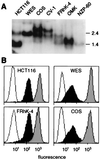Diversification, expression, and gamma delta T cell recognition of evolutionarily distant members of the MIC family of major histocompatibility complex class I-related molecules
- PMID: 9770516
- PMCID: PMC22861
- DOI: 10.1073/pnas.95.21.12510
Diversification, expression, and gamma delta T cell recognition of evolutionarily distant members of the MIC family of major histocompatibility complex class I-related molecules
Abstract
Distant relatives of major histocompatibility complex (MHC) class I molecules, human MICA and MICB, function as stress-induced antigens that are broadly recognized by intestinal epithelial gamma delta T cells. They may thus play a central role in the immune surveillance of damaged, infected, or otherwise stressed intestinal epithelial cells. However, the generality of this system in evolution and the mode of recognition of MICA and MICB are undefined. Analysis of cDNA sequences from various primate species defined translation products that are homologous to MICA and MICB. All of the MIC polypeptides have common characteristics, although they are extraordinarily diverse. The most notable alterations are several deletions and frequent amino acid substitutions in the putative alpha-helical regions of the alpha1 alpha2 domains. However, the primate MIC molecules were expressed on the surfaces of normal and transfected cells. Moreover, despite their sharing of relatively few identical amino acids in potentially accessible regions of their alpha1 alpha2 domains, they were recognized by diverse human intestinal epithelial gamma delta T cells that are restricted by MICA and MICB. Thus, MIC molecules represent a family of MHC proteins that are structurally diverse yet appear to be functionally conserved. The promiscuous mode of gamma delta T cell recognition of these antigens may be explained by their sharing of a single conserved interaction site.
Figures




References
-
- Beckman E M, Brenner M B. Immunol Today. 1995;16:349–352. - PubMed
-
- Germain R N, Margulies D H. Annu Rev Immunol. 1993;11:403–450. - PubMed
-
- Bjorkman P J, Parham P. Annu Rev Biochem. 1990;59:253–288. - PubMed
-
- Madden D R. Annu Rev Immunol. 1995;13:587–622. - PubMed
-
- Garboczi D N, Ghosh P, Utz U, Fan Q R, Biddison W E, Wiley D C. Nature (London) 1996;384:134–141. - PubMed
Publication types
MeSH terms
Substances
Associated data
- Actions
- Actions
- Actions
- Actions
- Actions
- Actions
- Actions
Grants and funding
LinkOut - more resources
Full Text Sources
Other Literature Sources
Molecular Biology Databases
Research Materials

